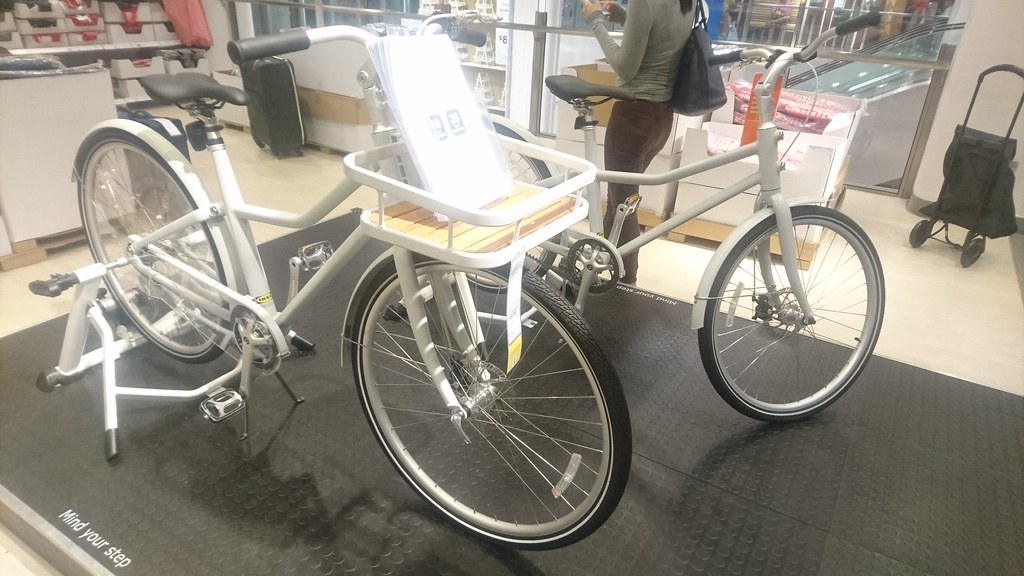One of the stranger bits of bicycle-related news from 2016 was that Swedish furniture titan Ikea was cooking up a bicycle of its own. Many wondered how the master of flat-pack furniture would pull it off.
I spent the final days of 2016 in Singapore, the country with arguably the closest Ikea stores to the Philippines. Just before I headed out the exit, I spotted the bike in question.

In keeping with Ikea’s Swedish nomenclature, the bike is christened “Sladda.”
As you can see from the photos, it’s basically their take on a mamachari, or a Japanese “grandma bike” made primarily for simplicity, utility, and travel. As such, the Sladda has an aluminum alloy frame with a downward-curving top tube enabling low standover height. You can simply step over the frame to mount it and ride off – instead of having to swing your leg over as you would with a bike with a horizontal top tube. Helping things along are a distinctly upright riding geometry, a tall stem, and a wide saddle.

Dismissing the Sladda as a mere mamachari clone is doing it a disservice, though, as you can see after looking at it up close. There’s got to be more to this S$900 (~PhP31,000) bike that earned it a Red Dot Design Award 2016 win, I reckon…
One of the demo bikes has an optional front rack for carrying loads, as seen on the first photo. Instead of installing it on the fork blades, however, Ikea took a page from folding bike makers Dahon, Tern and Brompton by bolting the rack to the head tube. This ensures that steering remains as stable as can be, regardless of the loads put on the front rack. It worked on small-wheeled bikes, so it will work better for stability on the 26″-wheeled Sladda.

Speaking of the fork, a single-piston Tektro mechanical disc brake caliper bolts onto its left blade’s IS mount, clamping on a 160 mm rotor. Followers of this blog will know that I am all for the all-weather reliability of disc brakes, and Ikea is wise enough to know that it’s the front braking, properly applied, that is more effective in shedding speed.
Check out the hidden fender mounts on the inside of the fork blades, too.

The front brake is controlled by this lone brake lever on the handlebar. The stubby little black lever may be mistaken for a shifter, but is actually a stealthy yet rather audible bell. Pull, then release to sound. Very neat.
If there’s only one lever, then does the Sladda have no rear braking?

Looking at the rear dropout area answers this question. The extra bolt on the underside of the chainstay secures a silver reaction arm, which is a dead giveaway that this bike has a rear coaster brake hub. On this type of brake, simply backpedal on the cranks to slow down.
More interesting details abound here too. That huge bolt is a hardpoint for mounting Ikea’s own rear rack. The smaller bolt below it has a telltale metal extension – the Sladda has full-length fenders with metal stays.

Looking upward, the same huge bolt resides on the wishbone-style seat stay junction – yet another hardpoint for mounting a rear rack.
What’s that bright red logo on the hub shell, though?

It reveals that this is actually a rather sophisticated SRAM Automatix two-speed internal gear hub. In keeping with the simplicity of the mamachari ethos, the Automatix shifts between its two gears by itself as you pedal along and your road speed increases. The no-shifter convenience does mean that the Sladda works best as a flatland bike.
A closer look at this particular Automatix hub reveals the Sladda’s most appealing feature, in my opinion.

You may have noticed already that this bike has no chain. The Sladda instead uses a drive belt. Instead of teeth meshing with a chain, the drivetrain uses notched pulleys that crank the toothed belt as it transfers drive to the rear hub. The main benefit of belt drive over a traditional chain is that it needs no lubrication and can theoretically last longer. The very existence of belt drive actually renders the Sladda’s full-length chain cover useless – it’s just there to give the bike a mamachari-like visual appeal.
Interestingly, the front drive pulley is made by Continental – famous for its bicycle and automotive tires. I never knew they were invested in belt drive, too.

I didn’t see the frame possessing any break points in the seat stay or horizontal dropouts which will enable a rider to adjust belt tension.

The Sladda has an eccentric bottom bracket for tensioning the drive belt instead. The two holes on top of the crank arm are turned by a pin spanner, which will effectively bring the crank spindle and the front drive pulley either farther or nearer to the rear wheel as it turns inside the bottom bracket shell. I’m assuming the two bolts beneath the bottom bracket shell are pinch bolts that are loosened to make belt tensioning easier.
Otherwise, the bottom bracket is your cheap yet robust square-taper affair. Below all that is a simple double-leg kickstand and simple, shiny flat pedals with reflectors.

The cockpit is also rather interesting. Riser handlebars are nothing new, but the adjustable-angle stem is fairly unusual. Don’t plan on getting into a very low and aggressive position with this bike though, as the stem’s angle pivot sits above a stack of spacers and the stem’s pinch bolts already.
Mounted to the handlebars is a black plastic clip which seems to be a mount point for a front light – similar to Cat Eye’s FlexTight bracket.

Rounding out the package are 26″ x 1.75″ (47-556) tires with full reflective sidewalls…

…and what looks like a relatively plush, wide saddle. It’s still a good shape for riders with high cadence, though, at least from the outset.

Overall, this is a very interesting bike. I can see why this thing won its “good design” award, because it really is a well thought-out commuter machine for people who just want to ride around town on errands under their own power, without complexity or mechanical knowledge. The front disc brake, full-length fenders, and belt drive transmission are very sensible choices – most likely the places where the cost went into. They even resisted using proprietary parts – belt drive transmission parts can be purchased online. The fact that Ikea is even offering a 25-year warranty on the frame and a 10-year warranty on the drivetrain means that its Swedes are seriously making an effort into replacing your car for short errands.

I can provide a few suggestions on how to make the Sladda better, but almost none of them involve preserving its simplicity. It’s that good. In terms of fitness for purpose, I gotta say – I came away impressed.

Reblogged this on Bikepacking Philippines.
LikeLike